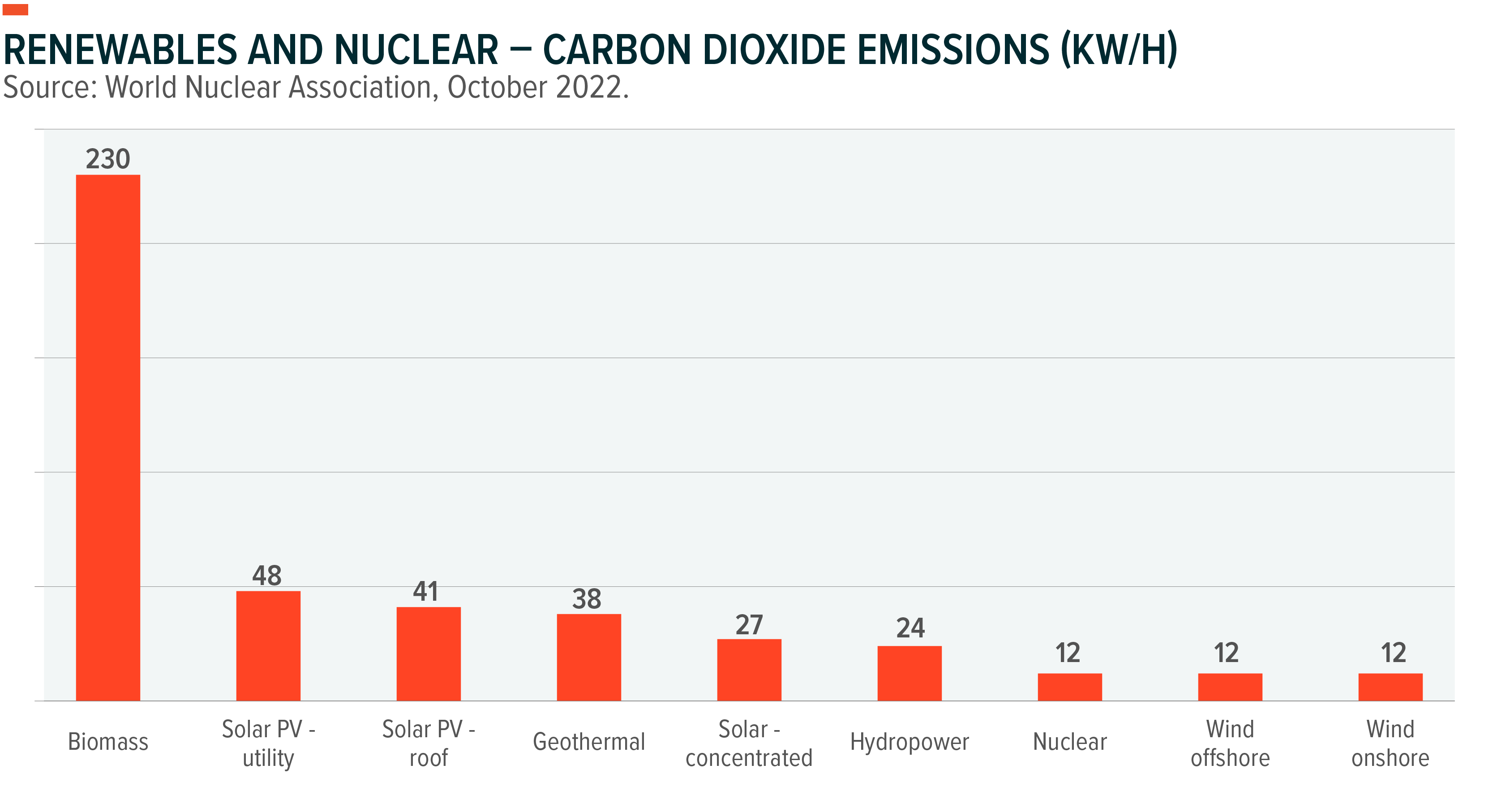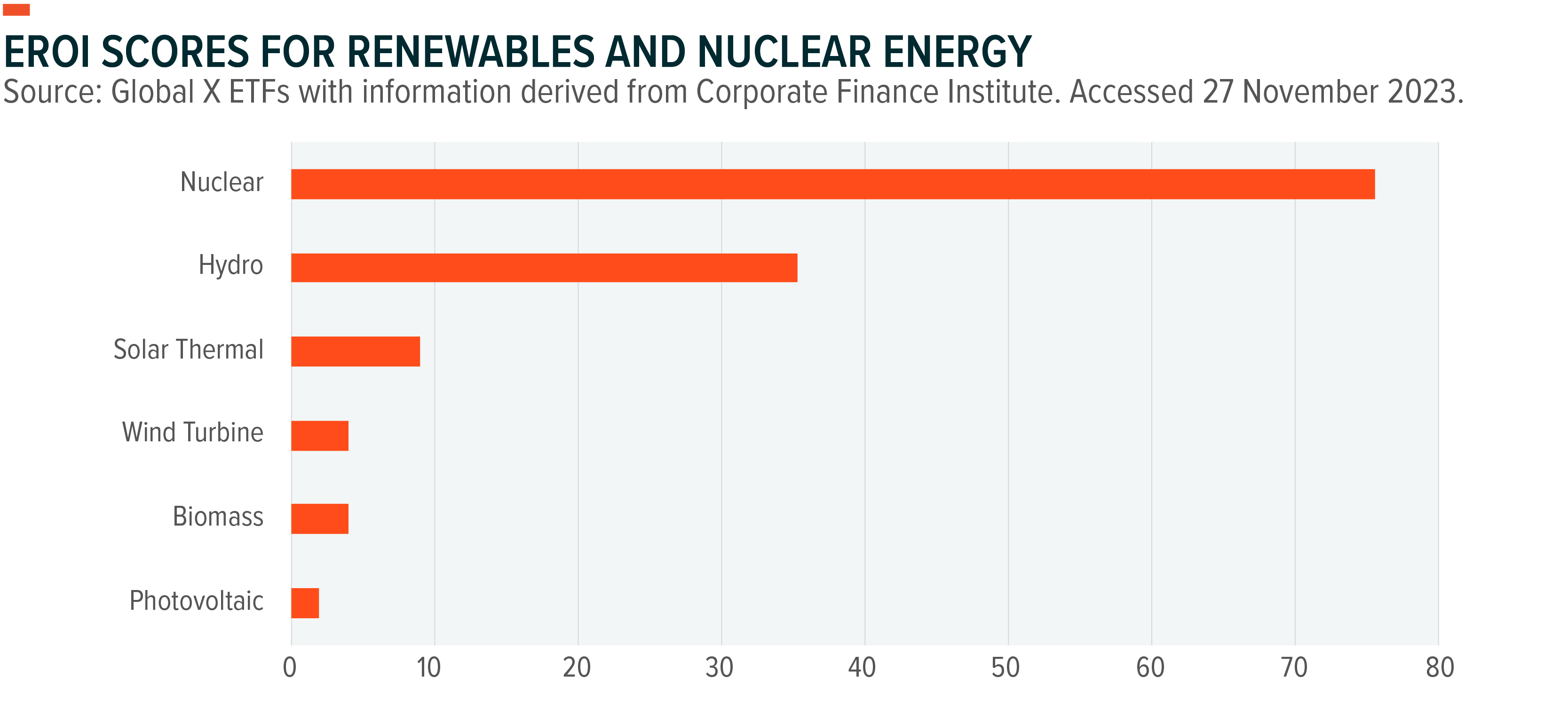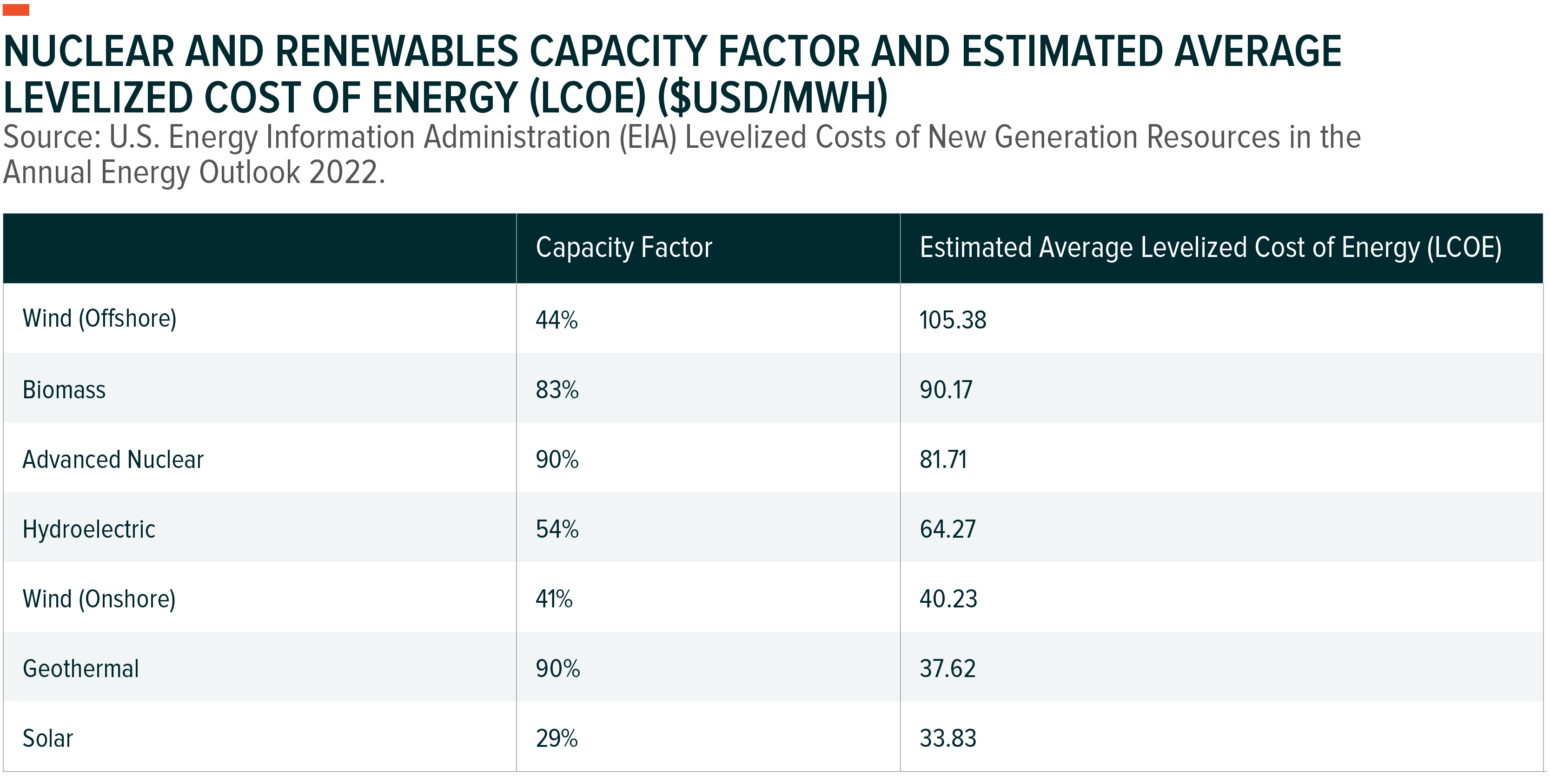Clean Energy Opportunities: Nuclear & Renewables Complement Each Other
At first glance, nuclear power and renewables don’t appear to have much in common. Wind and solar energy are decentralized and variable, while nuclear power is centralized and stable. But because they are both low-carbon, they are essential to the energy transition. There may even be an opportunity to integrate them into hybrid energy systems (HESs) that combine their best attributes into more dependable renewable energy generation to meet critical needs for clean heat, electricity, and food systems.
In this piece, we break down nuclear and renewable energy’s key attributes, highlight the ways in which the two can complement one another, and delve into the efforts to bring the two together. For investors, we believe that these energy sources, as pillars of the energy mix of the future, offer compelling growth potential across their value chains as the world shifts its energy priorities.
Key Takeaways
- Nuclear and renewable energy sources each bring unique attributes to the energy transition that governments can leverage as they plot future energy composition.
- The Nuclear Innovation Clean Energy Future (NICE Future) aims to promote nuclear energy in the broader clean energy discussion and explore its potential path to hybrid power plants.
- One concern that unites nuclear and renewable energy is waste, but recycling research and initiatives are expected to improve waste management.
Nuclear and Renewable Energy Making Their Mark in the Energy Transition
The major economies that are on track to decarbonize their energy grid, including Sweden, Finland, and the United Kingdom, all use a combination of nuclear and renewable energy sources.1 We expect others to follow suit, as nuclear and renewable energy’s unique features and their potential to interact can create an effective energy mix.
Like solar and wind energy sources, nuclear reactors do not generate any greenhouse gas (GHG) emissions during operation.2 To get them up and running is a different story. When estimating overall carbon emissions, including nuclear power plant and solar panel construction, nuclear energy emits less carbon than solar, biomass, geothermal, and hydropower, and it emits the same amount of carbon as wind.3

When comparing energy efficiency, nuclear power and hydropower are at the top of the list. The Energy Return on Investment (EROI) evaluates the efficiency of an energy source by comparing the usable energy output to the energy input required for its extraction or production. Energy sources are classified as energy sinks when their EROI is below 1.4

In terms of cost and capacity factor, wind (onshore), solar, and hydroelectric power are cheaper alternatives than nuclear in levelized cost of energy (LCOE) terms; however, these alternative energy sources are less reliable than nuclear energy, which operates at around 90% of capacity. Photovoltaic (PV) panels and wind turbines struggle with periodic outages because they are at the mercy of Mother Nature. Their output changes when the wind doesn’t blow and the sun doesn’t shine. Geothermal is the exception, having a high-capacity factor and a low LCOE. A drawback to geothermal power is that is highly location specific. 5,6
Importantly, when comparing power sources with different capacity factors, the final cost of energy production must incorporate storage costs because demand spikes and low energy output can necessitate storage reserves to prevent blackouts. The cost of battery storage (LCOE 128.55 $) is higher than nuclear’s (LCOE 81.71$) 7

New Energy Paths to Explore Include Nuclear-Renewable Hybrid Systems
Nuclear energy, which accounts for approximately one-third of the world’s emissions-free electricity generation, not only serves as a primary source of clean energy, but it can also facilitate the use of other clean energy sources.8 Helping to promote nuclear energy’s potential is the Clean Energy Ministerial, a global collaboration among governments, organizations, and companies that promotes clean energy and the energy transition.9
One of its primary initiatives is the Nuclear Innovation Clean Energy Future (NICE Future) program, led by the United States, Canada, and Japan. NICE Future engages a variety of stakeholders to concentrate on integrated renewable-nuclear energy systems, next-generation technologies, and full-scale nuclear for baseload electricity.10 In 2022, NICE Future initiated a campaign called Research the Impacts on Social Equity and Economic Empowerment (RISE3), which aims to expedite the substitution of unabated coal plants with advanced nuclear technology.11
As nuclear and renewable energy sources are the primary low-carbon alternatives, researchers are investigating the potential to merge them. Nuclear-renewable hybrid energy systems (HESs) may be able to harness the benefits of each technology into one sustainable and dependable energy source. Nuclear–renewable HESs could provide heat and electricity while increasing variable renewable generation through wind and solar photovoltaics. Other potential uses cases include district heating or cooling, seawater desalination, hydrogen production, tertiary oil extraction, cogeneration, coal to liquid conversion, and chemical feedstock synthesis.12
In the example of heat generation, nuclear plant operations can be optimized for electricity market conditions and demand to use waste heat from power conversion to generate district heating. Hybrid heating systems may improve energy security, local productivity, and GHG emissions. Technically, centralized heating systems could replace decentralized heating systems that use conventional energy sources such as gas, woodchips, and oil.13
The urgency to develop alternative energy systems to meet basic human needs while reducing GHG emissions cannot be overstated. Energy-food links, for example, are core to addressing issues stemming from population growth, poverty, and climate change. The energy-food nexus focuses on energy usage in food production, processing, storage, transit, retail, preparation, and cooking. Food consumption accounts for 30% of worldwide primary energy consumption. That consumption includes significant fossil fuel usage and produces 20% of yearly GHG emissions, excluding plant deployment-related land use changes.14

Recycling Research Aims to Dispel Waste Management Concerns
Concerns about managing radioactive waste are among the primary obstacles to the widespread adoption of conventional nuclear fission. Also problematic are ageing renewable energy systems, which could generate tens of millions of tonnes of garbage in the coming decades. We estimate global end of life (EoL) solar panel trash to approach 61 million tonnes by 2045. By the early 2040s, wind turbine blade waste could exceed 14 million tonnes.15
The nuclear power business generates little waste by comparison. From the beginning of nuclear electricity production in 1954 through 2016, the nuclear power industry produced approximately 390,000 tonnes of spent fuel.16 In addition, radioactive waste transport, storage, and disposal are safe and technologically proven. Less than 10% of U.S. hazardous waste is radioactive.17 Roughly two-thirds of waste is stored and one-third is recycled.18
There are many research projects ongoing that aim to improve renewable and nuclear energy spent fuel management. Companies across the wind and solar power value chain are accelerating recycling efforts and developing new technologies in an effort to improve renewable energy’s sustainability. Vestas, a renowned wind turbine manufacturer, proposed a chemical recycling process in February 2023 that might revolutionize the industry.19 Also, in 2021 the U.S. Department of Energy announced funding for an Advanced Research Projects Agency-Energy (ARPA-E) program up to $40 million. This program limits advanced nuclear reactor waste, protecting the environment, and promotes nuclear power as a clean energy source.20
Conclusion: The Backbone of New Energy Mix Can Be Nuclear & Renewable
Leveraging the differences and similarities of renewables and nuclear energy can be a key path towards accelerating decarbonization and make for a compelling investment case. Although the full potential of nuclear-renewable HESs may vary depending on the deployment region and energy market structures, research indicates that these systems’ flexibility and resilience can play a key role in meeting energy needs. Adding to the investment case is that waste management improvements are expected to increase nuclear and renewable energy’s long-term sustainability.
